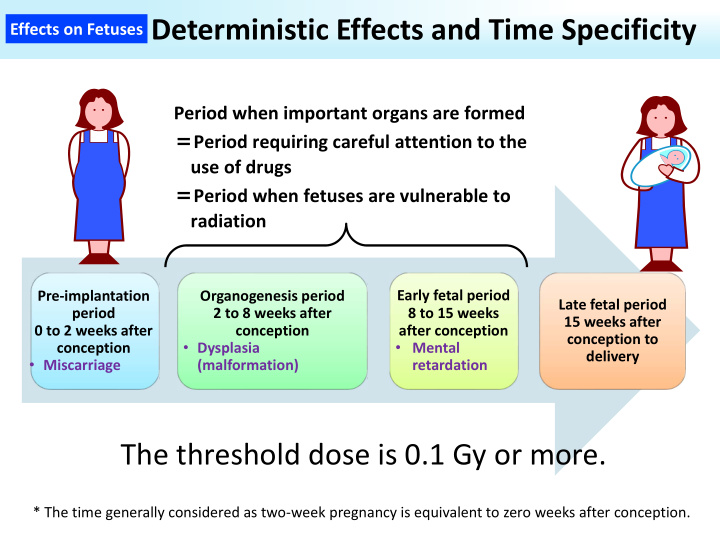



Deterministic Effects and Time Specificity Effects on Fetuses Period when important organs are formed = Period requiring careful attention to the use of drugs = Period when fetuses are vulnerable to radiation Pre‐implantation Organogenesis period Early fetal period Late fetal period period 2 to 8 weeks after 8 to 15 weeks 15 weeks after 0 to 2 weeks after conception after conception conception to • Dysplasia • Mental conception delivery • Miscarriage (malformation) retardation The threshold dose is 0.1 Gy or more. * The time generally considered as two‐week pregnancy is equivalent to zero weeks after conception.
Mental Retardation Effects on Fetuses Data on Atomic 80 Bomb Survivors Risks of a severe intellectual disability (%) All ages in weeks 70 8 to 15 weeks 60 16 to 25 weeks 50 40 30 20 10 0 0.0 0.5 1.0 1.5 Doses within mothers' wombs (Gy) Source: Prepared based on "Physical and Mental Development of Children Exposed to Radiation in Their Mothers' Wombs" on the website of the Radiation Effects Research Foundation(https://www.rerf.or.jp/programs/roadmap/health_effects/uteroexp/physment/)
Effects on Children ‐ Chernobyl Nuclear Accident ‐ Effects on Fetuses Survey on children born from mothers who were pregnant at the time of the Chernobyl accident Survey targets (i) 138 children who were exposed to radiation in the womb and their parents (a group of children exposed to radiation in the womb: exposed group) (ii) 122 children in non‐contaminated regions in Belarus and their parents (control group: non‐exposed group) When aged 6 to 7 When aged 10 to 11 Children's mental development (i) Exposed group (ii) Control group (i) Exposed group (ii) Control group 18.1 % 8.2 % 10.1 % 3.3 % Difficulty in speech 20.3 % 7.4 % 18.1 % 7.4 % Disorder of emotion IQ=70 〜 79 15.9 % 5.7 % 10.1 % 3.3 % ○ A significant difference in mental development was observed between the exposed group and the control group, but there was no correlation between exposed doses and intelligence quotients. Therefore, the difference was considered to be attributable to social factors associated with forced evacuation. ○ There was correlation between parents' extreme anxiety and their children's emotional disorders. It is considered that radiation exposure during pregnancy does not directly affect intelligence quotients of fetuses and children after growth. Source: Kolominsky Y et al., J Child Psychol Psychiatry, 40 (2): 299‐305, 1999
Knowledge on Malformation Induction Effects on Fetuses ‐ Chernobyl Accident ‐ Has the Chernobyl accident increased malformation? Comparison of European congenital malformation/twin registry database between before and after the Chernobyl accident European Surveillance of Congenital Anomalies (EUROCAT): 18 regions in 9 countries: No change in incidence of malformations before and after the accident Finland, Norway, Sweden: No change in incidence of malformations before and after the accident Belarus: Increase in registration of malformations of aborted fetuses regardless of whether from the contaminated areas or not Possibility of reporter bias * 1 Ukraine: participated in EUROCAT in this century Increase in neural tube defects in an isolated Polish community in the Rivne province It is necessary to evaluate the influences of folate depravation, alcoholism, consanguineous marriage, etc., in addition to radiation. * 2 Source ︓*1 :Stem Cells 15 (supple 1): 255, 1997 *2 :Pediatrics 125:e836, 2010
Recommend
More recommend